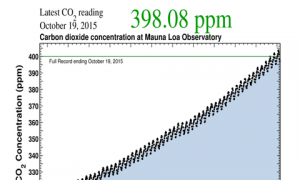Earlier this week Andrew Revkin of the New York Times posted a blog article discussing the latest carbon dioxide measurement from Mauna Loa, where records have been kept since the International Geophysical Year of 1958. The October 19 measurement shows that the concentration of CO2 is now 398.08 parts per million. As Northern Hemisphere winter begins and plant matter goes into dormancy, carbon dioxide levels are expected to rise as usual on their annual oscillation. This seasonal oscillation, coupled with the continuous rise in CO2 across the globe and the impacts of the strong El Niño, which cause drought, fires and plant death in Indonesia and other tropical locations, is expected to rise to higher levels in the coming months. In fact, some scientists predict that the measured monthly values will never go lower than 400 ppm in the foreseen future.
Not all of the effects of increased carbon dioxide are bad. There is some fertilization by increased CO2 on plant growth, particularly if they have enough water. But noxious weeds like poison ivy also respond to the increased CO2, causing more problems for farmers. Overall, the impact of increased CO2 on the atmosphere’s energy balance are expected to drive the planet’s temperatures higher and higher as the years progress, although the rate at which that will occur is not certain.
If you are wondering where the increased carbon dioxide in the atmosphere is coming from, there is a good explanation of this at Skeptical Science here. Another source is the US EPA here. Some of it is attributed to changes in land use such as the conversion of tropical forests to farms and palm plantations. Much of it can be attributed to the burning of fossil fuels like coal and oil–this is easily identified by the age of the carbon (dated through radiocarbon dating) as millions of years old.
